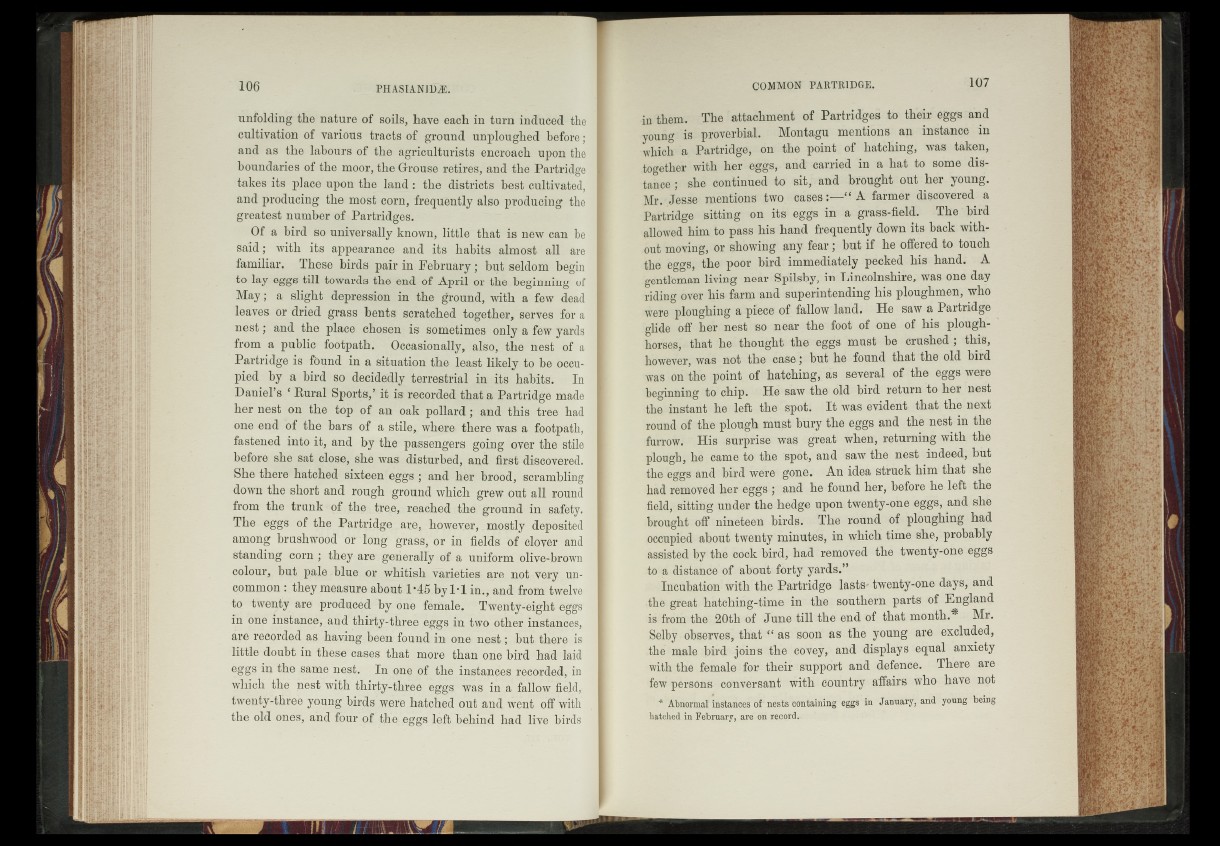
unfolding the nature of soils, have each in turn induced the I
cultivation of various tracts of ground unploughed before; I
and as the labours of the agriculturists-encroach upon the I
boundaries of the moor, the Grouse retires, and the Partridge I
takes its place upon the land: the districts best cultivated, Jj
and producing the most corn, frequently also producing the 1
greatest number of Partridges. *
Of a bird So universally known, littlerthat is new can bell
said; with its appearance and itcs habits almost all. are |
familiar. These birds pair in February ; but seldom begin I
to lay eggs till towards the end of April or the-beginning
May; a slight depression in the ground, with a few dead I
leaves or dried grass bents scratched together, serves for a I
nest ; and the place chosen is sometimes only a few y&rds fl
from a public footpath. Occasionally,.-also, the neSt of a il
Partridge is found in a situation the least. l%Iy-Jo be fceu- 1
pied by a bird so decidedly terrestrial in .its habits. In I
Daniel’s ‘ Rural Sports,*' it is recorded that a Partridge made 1
her nest on the top of an oak pollard; and this tree had 1
one end of the bars of a stpe^where there was a footpath, %
fastened into it, and by the'passengers -going over the stile
before she sat close, she was disturbed, and fii^fa<§lscovered.
She therediatched sixteenreggs and her brood, scrambling 1
down the short and rough ground which grew out all round
from the trunk-yof the ; ^.4ete, • reached theiground^in-'safoty. j
The. eggs of the Partridge howe.v.er, _raps,tly--dep0.sited i
among brushwood1 or '■grabs, or iri '‘fie'fds fid I
standing co£|y- they areygenemnipofs. a uniform olive-brown q
colour, but, pale .blue or whitish varietiejpr.are not^veiy: un- I
common : they measure about i^5,by 1*1 in., and from* tWOlvolS
to twenty are produced byiiSe female. ' TwentyJeighf%gg8‘ M
in one instance; and* thirty-three eggs in t||o other instances, -
are recorded as having-been* found in one nest;. but, there is *<,
little doubt in thes#e&ses that more' than one bird had laid
the same nest,. In one of the fo^tapfie|i.ie^rde^rtiii M
which the ff|pfjwith thirty-three ,egg|j was in a lallqjpjpojd,. I
twenty-three young ^irdsrw©re batched out ,and went off with |
the olef ones, an (flour ef the, figgs left behind had liyc lii-rds B
in them. The attachment of Partridges to thbir. eggs and
young is proverbial. Montagu mentions an instance in
which a Partridge, on the point of hatching, was taken,
together with her eggs, and carried in a hat to some distance;
she continued to sit,-and brought out her young.
Mr.-Jesse mentions two c a s e s f a r m e r discovered a
Partridge sitting on its; eggs in a grass-field. The' bird
allowed him to pass his hand frequently down its hack without
moving, or showing any fear; but if he offered to touch
the eggs, the poor bird: immediately pecked his hand. A
gentleman living near Spilsby, in Lincolnshire, was one day
riding oveT his farm and superintending his ploughmen, who
were ploughing a piece o;f fallow land. He saw a Partridge
glide off her nest so near the foot of one of his plough-
homes, that he .thought the eggs must he crushed; this,
however, was not the case j hut he found that the old bird
was on the point of hatching, as several of-the eggs were
beginning to chip. Ho saw the Old bird return to her nest
the instant he left the- spot". It was evident that thenext
round of the plough must bury the eggs and the nest in the
furrow. His .surprise was great when, returning with the
plough, hè came to- the Spit, and saw the nest indeed, biit
the eggs and bird were" gone. An idea struck him that she
had removed her eggs ; and he found her,-before he left the
field, sitting under the'hedge upon twenty-one eggs, and she
brought off nineteen birds. "The round of ploughing had
Occupied about twenty minutes, in which time she/probably
assisted by the cock bird, had removed the twenty-one eggs
to a distance'of''about-forty yards.” A"
Incubation with -t'hfe Partridge lasts' twenty-one days, and
.the great hatching-time, in the southern parts of England
is from the-20th of June till the end of that month.* - Mr.
Selby. observes, that “ as soon as the young are -excluded,
.the male bird -joins the covey, and displays «equal anxiety
with the female for their support and defence. -There are
few persons conversant -with.country affairs who have not
* i *''Abnörtaaf iMtances of' nests'-containing eggs' in January, andyoteng'being
hatched in February, are on recofd..^